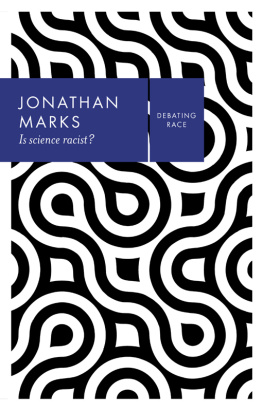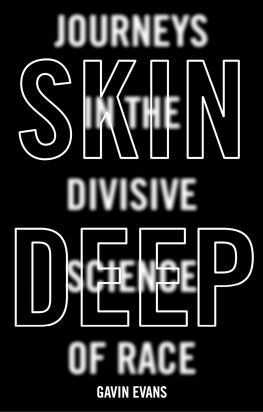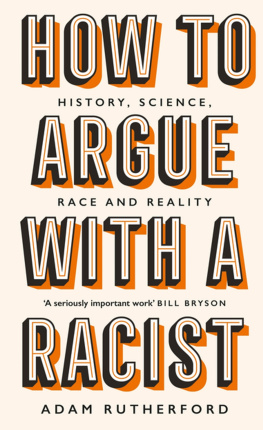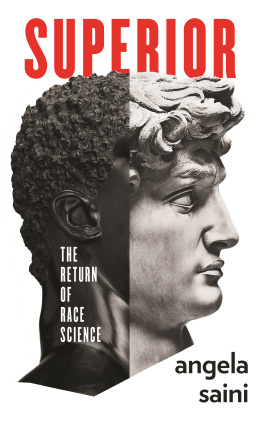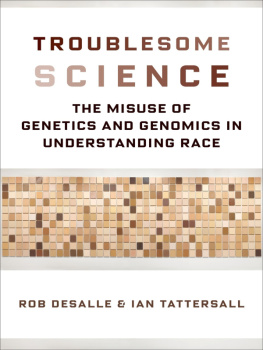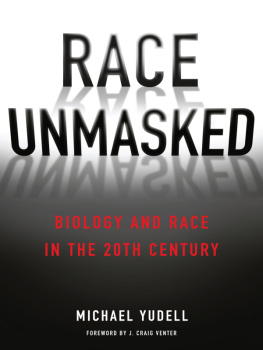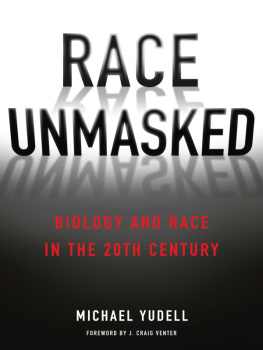
Series page
Debating Race series
- David Theo Goldberg, Are we all postracial yet?
- Ghassan Hage, Is racism an environmental threat?
- Jonathan Marks, Is science racist?
Copyright page
Copyright Jonathan Marks 2017
The right of Jonathan Marks to be identified as Author of this Work has been asserted in accordance with the UK Copyright, Designs and Patents Act 1988.
First published in 2017 by Polity Press
Polity Press
65 Bridge Street
Cambridge CB2 1UR, UK
Polity Press
350 Main Street
Malden, MA 02148, USA
All rights reserved. Except for the quotation of short passages for the purpose of criticism and review, no part of this publication may be reproduced, stored in a retrieval system, or transmitted, in any form or by any means, electronic, mechanical, photocopying, recording or otherwise, without the prior permission of the publisher.
ISBN-13: 978-0-7456-8921-0
ISBN-13: 978-0-7456-8922-7(pb)
A catalogue record for this book is available from the British Library.
Library of Congress Cataloging in Publication Control Number: 2016029623
Typeset in 11 on 15 pt Adobe Garamond
by Toppan Best-set Premedia Limited
Printed and bound in Great Britain by Clays Ltd, St Ives PLC
The publisher has used its best endeavors to ensure that the URLs for external websites referred to in this book are correct and active at the time of going to press. However, the publisher has no responsibility for the websites and can make no guarantee that a site will remain live or that the content is or will remain appropriate.
Every effort has been made to trace all copyright holders, but if any have been inadvertently overlooked the publisher will be pleased to include any necessary credits in any subsequent reprint or edition.
For further information on Polity, visit our website:
politybooks.com
Dedication
To my parents Richard and Rene,
to my wife Peta,
and to our daughter Abby
Acknowledgments
I started writing this book while I was a Templeton Fellow at the Notre Dame Institute for Advanced Study, and probably should have been working on my project, Tales of the ex-Apes (University of California Press, 2015). That project came to happy fruition, and now so too has this, and I am very grateful to the John Templeton Foundation and to the Notre Dame Institute for Advanced Study for their stimulation and support.
I have been strongly influenced by the voices of friends and colleagues who have helped me to clarify my own thinking, while sharing theirs. That is a group that includes Troy Duster, Jay Kaufman, Jonathan Kahn, Dorothy Roberts, Duana Fullwiley, Kim TallBear, Alan Goodman, Deborah Bolnick, Susan Reverby, Evelynn Hammonds, Joseph Graves, Richard Cooper, Anne Fausto-Sterling, Pilar Ossorio, Lundy Braun, Terence Keel, and others.
I thank Jonathan Kahn and Julia Feder for their insightful comments on the manuscript, and Karen Strier for long-term wisdom.
One
Introduction
Racism pervades many, if not all, aspects of modern society, in different ways. Like other modern institutions, science can sometimes reflect the subtle and not-so-subtle biases of its practitioners. This book is not about the institutions and practices of science, however, but about its content.
I teach two principal subjects as a biological anthropologist: human diversity and human origins. These are about, respectively, who we are and where we come from. For any other society, this would be considered a sacred origin myth, a domain of kinship, by which people establish their orientation in a complex social universe. In our society, it involves the contested scientific domains of race and evolution, both of which are conceptualized rather differently than they were a few decades ago.
Evolution, for example, used to be conceptualized reductively without bodies, and without species as simply genotypes and gene pools. Any contemporary discussion of the subject, however, now considers the reactivity and adaptability of the body (plasticity), the reciprocal relations between the environment and the species (niche construction), and nongenetic modes of inheritance (epigenetics and culture).
Race, likewise, has been reconceptualized in the last few decades. Where it was once conceptualized as a fundamental unit of the human species, we now know that the species does not really come partitioned that way. That is a fallacy of primary interest to pedants, like me, and we can call that taxonomic fallacy racialism. More significant is the recognition that the social and behavioral differences between any two groups of people are far more likely to be due to the processes of history than to those of microevolution. Consequently, the judgment of innate individual properties on the basis of group membership is illegitimate, and we can call that political position racism.
Nevertheless, when dealing with ancestors and relatives, one never traffics in value-neutral facts. Kinship is invariably bio-cultural. The opposite of evolution creationism is so political that its history actually is just a series of court cases in the United States: Tennessee vs Scopes (1925), McLean vs Arkansas (1982), Edwards vs. Aguillard (1987), and Kitzmiller vs. Dover School District (2005) are just the most familiar ones. And racism is most familiar as political acts: slavery, segregation, anti-Semitism, once again, to name only the most familiar examples.
This book is about a paradox in science. Both creationism and racism are considered outmoded ideologies. If you espouse creationist ideas in science, you are branded as an ideologue, as a closed-minded pseudo-scientist who is unable to adopt a modern perspective, and who consequently has no place in the community of scholars. But if you espouse racist ideas in science, that's not quite so bad. People might look at you a little askance, but as a racist you can coexist in science alongside them, which you couldn't do if you were a creationist. Science is racist when it permits scientists who advance racist ideas to exist and to thrive institutionally.
Consider an op-ed that appeared in the New York Times on April 11, 2014, called Raising a Moral Child, which casually cited a classic experiment by the psychologist J. Philippe Rushton.1995: 1133).
Rushton believed, and believed that his data showed, that there are three kinds of people associated with the continents of the Old World (a biogeographic scenario that in fact owes more to the biblical sons of Noah than to modern biology). Moreover, the peoples of Africa had undergone eons of natural selection for high reproductive rate and low intelligence, which he measured via surrogate variables notably, sex drive, criminality rates, penis size, and brain size; the peoples of Asia had undergone selection for low libido and high intelligence; and the peoples of Europe comprised a happy medium. He believed that the average sub-Saharan African had the IQ of a mentally handicapped European. Yes, he was a racist crackpot. Anybody who ever took the trouble to examine his inane corpus of work could see that.
When Philippe Rushton died in 2012, he had been president of The Pioneer Fund for a decade, a philanthropy that carefully selects its academic beneficiaries, ranging from eugenicists in the 1930s to segregationists in the 1960s, and radical hereditarian psychologists notably Rushton himself in the 1980s (Tucker, 2002). Clearly this was a man who was utterly incapable of rendering sober, informed, scientific judgments; simply a wacky ideologue with a PhD and the admiration of some wealthy and powerful misanthropes. Yet somehow he had risen to a position of status and authority in certain areas of science. Indeed, the
Next page
